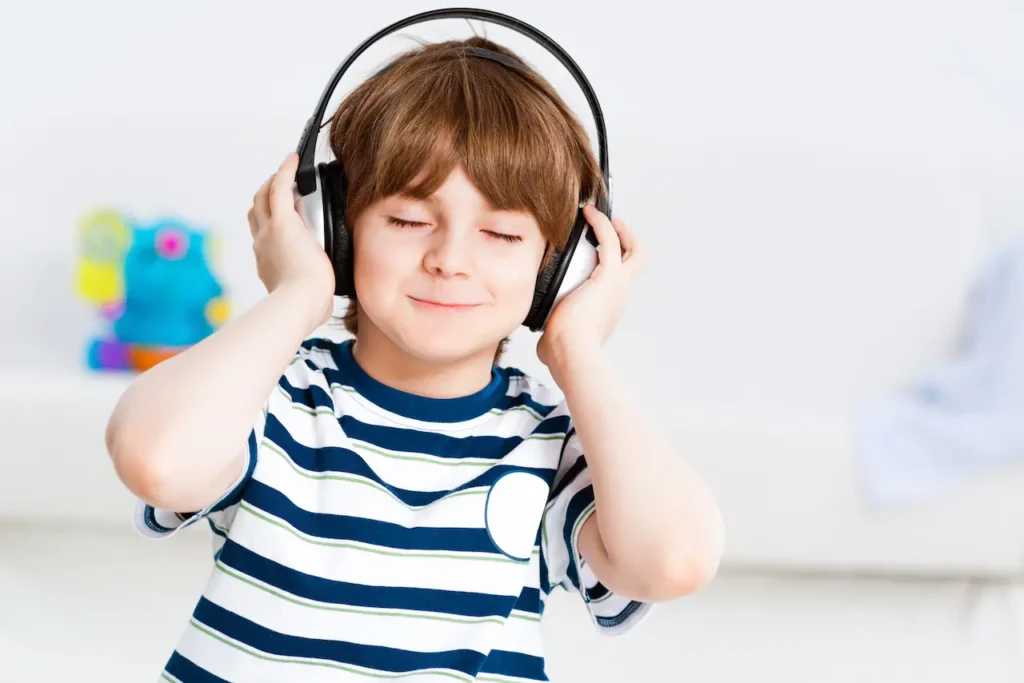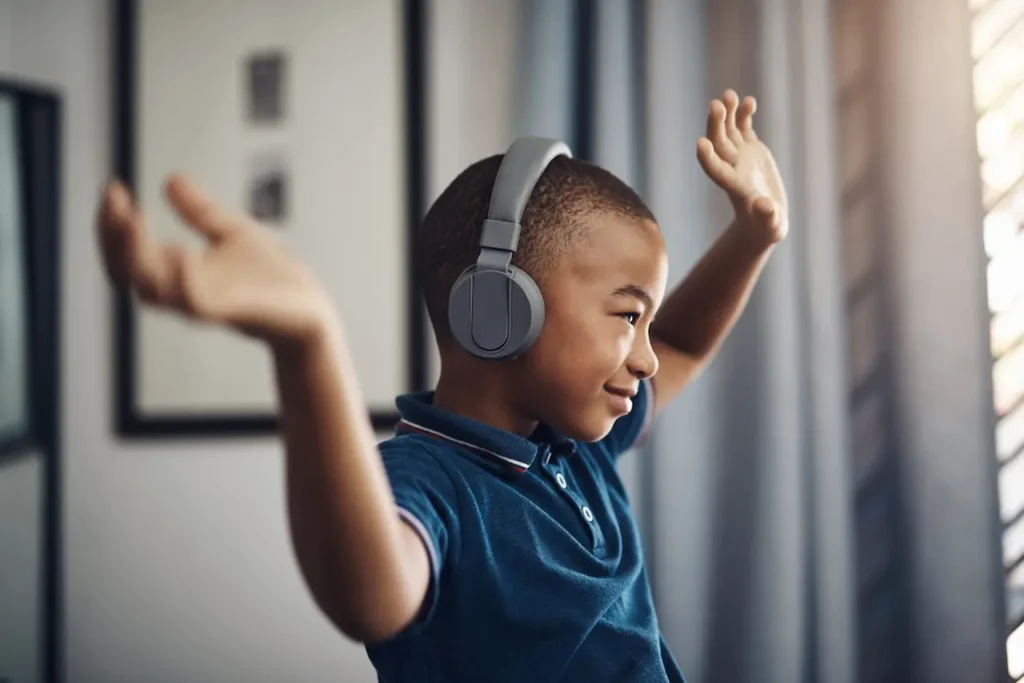Are Your Kids Often Using Headphones?
Are Your Kids Often Using Headphones? What can you do to protect their little ears?
Children use headphones to do a wide range of things in the digital age. They may be using them for online learning, to watch videos, to play games or to listen to music. Headphones are a part of every child’s routine, whether it is for remote learning, keeping in touch with family, or listening to their favourite songs and shows. As convenient as headphones are, they can be harmful to children’s ears if misused or overused.
Parents must take proactive measures to protect their children’s hearing, even though they may not understand the dangers associated with loud noises. We’ll explore why hearing protection matters, the dangers of excessive headphone usage, and what parents can do to protect their child’s ears.

Growing concern about hearing loss in children
Hearing loss is permanent and cannot be reversed. It is therefore important to protect your hearing throughout life. We are all aware of the guidelines for workplace noise exposure that protect adults. Unfortunately, hearing loss among children is also on the rise. Researchers in 39 countries conducted a study that revealed nearly 13% of children have measurable hearing losses by the time they reach age 18. This could affect their ability to hear clearly. The reasons behind this alarming increase in hearing loss have not been fully explained.
The use of headphones is one factor that has been a source of concern. There is no conclusive proof that headphone use causes hearing loss in kids, but some studies suggest that headphones and portable music devices may be a contributing factor. In a Dutch study, 14% of participants aged 9-11 had measurable hearing losses, and 40% reported that they used portable music devices and headphones. The potential dangers of children using headphones are worth considering, even though more research is required.
How Can We Tell If Our Child’s Hearing is Affected?
Children may not be able to express themselves clearly if they have hearing problems. Adults are usually able to detect hearing issues by being unable to hear high-pitched sounds or muffled noises. They may also notice a buzzing, ringing sound called tinnitus. Children may not be able to recognize the symptoms as adults do, and they may describe them in terms that are more understandable, like “a bee buzzing”, or “the air blowing.”
Parents should be concerned if their child complains of any strange sounds or symptoms. They should seek out a hearing test. If you are in a rural area, it is best to visit a hearing clinic and, if needed, consult a GP.
Hearing Damage from Excessive Noise
The inner ear contains tiny hair cells which play an important role in hearing. These hair cells convert the sounds that we hear into electrical impulses, which the brain can interpret. These hair cells are tuned to detect the different pitches, similar to keys on a piano. These delicate hair cells may be damaged by loud noises. Repeated exposure to loud sounds can lead to permanent hearing loss. The damage can often occur before symptoms appear, making it important to prevent any damage from occurring.
Protecting your Child’s Hearing: Tips for Parents
Both the volume of sound and the duration are important factors in determining the risk of damage to the ears from using headphones. There are some practical measures parents can take in order to reduce these risks and protect the hearing of their children.

1. Limit Loudness
The volume of sounds that children hear is an important aspect of hearing protection. The decibel scale, which measures sound intensity in decibels (dB), is logarithmic. Every increase of 10 decibels represents a tenfold rise in sound intensity. A 110 dB (like the sound of a chainsaw), is louder than 100 dB (like that of a jackhammer) even though there’s a mere 10 dB difference.
While most conversations are around 60 dB in volume, prolonged exposure to sounds above 85 dB can be dangerous. Some parents may not be aware that using headphones can be dangerous, as some headphones are designed to insulate the sound and make it difficult to determine how loud a volume is.
Try the following to monitor your child’s use of headphones:
- Try the headphones on yourself. If the music or sound is too loud for your ears, then it will be too loud for a child.
- Test if your child is able to hear you. Try calling your kid from a distance of an arm’s width. The volume of their headphones may be set at a safe setting if they can hear you.
- Invest in headphones that are safe for children: Choose headphones with a maximum sound level of 85 dB or less. It is important to have this feature so that your child does not accidentally turn the volume up.
You can also reduce background noise by using noise-cancelling headsets. They can keep the volume low, as children will not feel the need for a higher volume to drown out outside sounds. Noise-cancelling headsets can be expensive but they are a good investment for hearing protection.
2. Manage Duration
Parents should limit the volume of sound their children hear, but also consider how long they expose them to it. Even moderately loud sounds can cause damage to the ears if they are exposed for a long time. A sound of 85 dB (such as that from a garbage truck) can be tolerated safely for approximately 8 hours. If the sound increases to 88dB, however, the exposure time is reduced to only 4 hours. Sound levels above 100 dB, such as a chainsaw, should be kept to 15 minutes in order to prevent hearing damage.
Remember that noise exposure can be cumulative. The total sound exposure your child receives throughout the day, including from toys, television, music, and headphones, adds up. Protect your child’s ears by:
- Monitor your child’s daily exposure. If you or your child listens to loud music, uses headphones, or plays noisy toys throughout the day, schedule breaks. Give their ears time to recover and rest after exposure to loud sounds.
- Avoid consecutive loud activities. Try to avoid letting your child wear headphones after engaging in a loud activity, such as playing noisy toys or listening to music. Include quiet time in your schedule to help balance the noise.
- Encourage your child to take breaks to listen. One simple strategy is to make it a rule for them to remove their headphones before they enter the bathroom or kitchen. This will encourage them to take regular breaks.
3. Talk to Your Children about Hearing Protection
You must talk to your kids about the dangers of high-volume music and sounds. Loud sounds can cause damage even if your child doesn’t feel pain or discomfort. The sooner children are aware of the dangers, the better they will take care of their ears.
Discuss these key points with your child.
- The effects on hearing loss: Explain how hearing loss feels and why it is important to protect the ears. Mention symptoms such as tinnitus, muffled sound or difficulty understanding others. These issues can cause people to feel left out and unable to hear others in noisy situations.
- Breaks are important. Teach your children to take breaks, and rest their ears after using headphones for a long time. They must know that their hearing should be protected throughout their lives.
4. Consider Noise-Cancelling Headphones
Noise-cancelling headsets are an excellent way to reduce background sound and lower the volume. Children may turn up the volume to drown out noises in noisy environments. Noise-cancelling headsets can help reduce this need.
Over-ear headphones are better for reducing noise from outside than in-ear or earbud headphones. Noise-cancelling headsets also offer an additional benefit, as they make listening more comfortable for your child.

5. Avoid using headphones while sleeping
It is not a good idea to use headphones while sleeping. It is not a good idea to use headphones while sleeping. The risks of exposure are higher and can disrupt sleep and relaxation. Children may not be aware if they are being exposed to too much sound while sleeping. Consider using a speaker instead if your child enjoys listening to podcasts or music before going to bed.
6. Regular Hearing Screenings
Regular hearing tests are essential to protecting your child’s ears. Your child should have their hearing checked at least three times a year, or more often if there are signs of hearing loss such as difficulty in understanding speech and asking people to repeat things.
Encourage your child to also report any unusual symptoms of the ear, such as ringing or muffled sound, or even a pressure feeling. Even temporary symptoms can indicate that the problem could return or become permanent.
Conclusion
It is important to protect your child’s ears for their health and wellbeing in the long term. Parents must make sure that headphones are used safely and responsibly. Parents can protect their children’s ears by monitoring volume, managing headphone usage, educating children on the dangers of hearing loss and encouraging frequent breaks. These simple steps will help you protect your child’s ears and allow them to enjoy the sounds around them.



